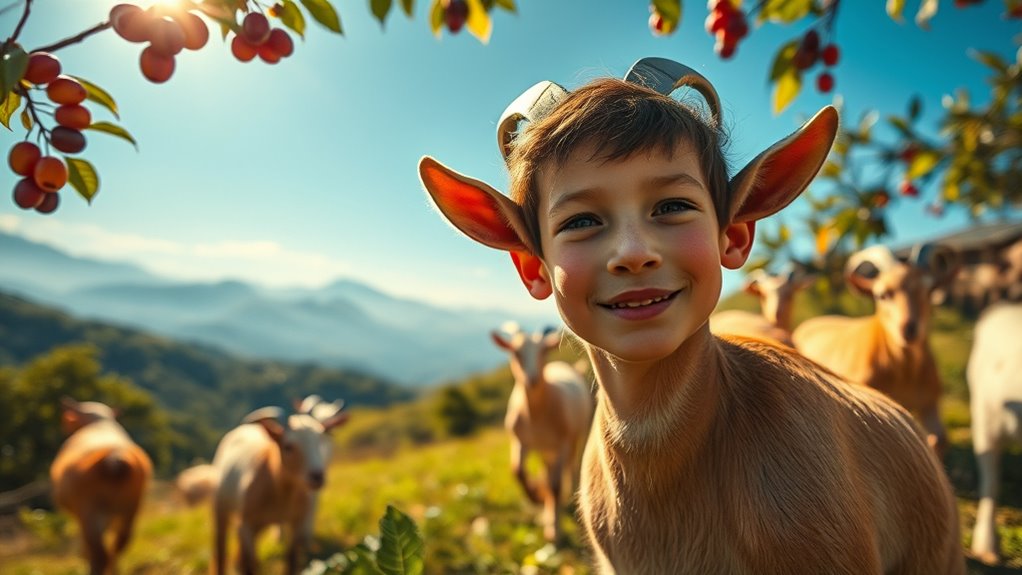Kaldi, a legendary Ethiopian goat herder, noticed his goats becoming lively after eating bright red berries. Curious, he tried the berries himself and discovered their energizing effects. This story, known as Kaldi and the dancing goats, highlights the magical origins of coffee and the role of local knowledge. If you want to uncover more about how this myth shaped coffee’s history and cultural significance, there’s plenty more to explore.
Key Takeaways
- The legend attributes coffee’s discovery to Kaldi, an Ethiopian goat herder, who noticed goats energized after eating red berries.
- Kaldi’s story symbolizes curiosity and natural resource discovery, highlighting coffee’s origins in Ethiopian highlands.
- The tale of dancing goats reflects the energizing effects of coffee, inspiring early cultivation and local use.
- Coffee’s legend emphasizes the importance of local knowledge in shaping trade routes and cultural significance.
- Modern appreciation of coffee often references Kaldi’s story to celebrate its historical and cultural roots.

Kaldi, a legendary Ethiopian goat herder, is often credited with discovering coffee’s energizing effects when he noticed his goats becoming lively after eating certain red berries. This story, passed down through generations, forms the foundation of many historical legends surrounding coffee. As you explore the origins of this beloved beverage, you’ll see how these tales intertwine with the development of coffee cultivation across Ethiopia and beyond. The legend isn’t just a charming story; it’s a window into the early days of coffee’s journey from wild plants to a global commodity. In its earliest days, coffee was likely discovered in the wild, growing naturally in the Ethiopian highlands. Local communities, inspired by stories like Kaldi’s, began to recognize the energizing effects of these berries and started experimenting with them. Over time, they learned how to cultivate coffee intentionally, selecting the best plants and spreading their knowledge throughout the region. Coffee cultivation, hence, started as a local, community-driven effort rooted in tradition and observation. These early efforts set the stage for the spread of coffee as an essential crop, eventually reaching the Arab world, where it became deeply embedded in culture and trade. The legends surrounding Kaldi have helped shape the romantic image of coffee’s origins, emphasizing a sense of discovery and curiosity that still resonates today. As you learn more about the history of coffee, you’ll notice how these stories highlight the importance of local knowledge and natural resources in shaping global trade routes. Coffee cultivation expanded beyond Ethiopia as traders and explorers recognized its value, fueling demand across the Middle East, Europe, and eventually the world. Today, coffee remains a symbol of social connection, energy, and innovation—qualities that trace back to those early days when Kaldi’s goats first danced with joy after tasting the berries. Interestingly, modern coffee research continues to explore new methods of cultivation and brewing to enhance flavor and sustainability. Understanding these legends enriches your appreciation of coffee’s rich history, reminding you that every cup you enjoy is part of a story that spans centuries and continents. Additionally, the role of attention in cultivating a deep appreciation for coffee’s nuances can be seen in how baristas and enthusiasts focus intently on brewing techniques. The narrative of Kaldi and his dancing goats underscores how legends influence the perception of coffee’s origins, inspiring both wonder and respect for the journey that brought this remarkable beverage into your hands.
Frequently Asked Questions
What Are the Different Varieties of Coffee Beans?
You might wonder about the different coffee plant varieties and bean processing methods. There are mainly four coffee bean varieties: Arabica, Robusta, Liberica, and Excelsa. Each offers unique flavors and qualities. Bean processing methods like washed, natural, and honey processing influence taste and aroma. By understanding these varieties and methods, you can better appreciate the diversity in coffee flavors and find your perfect cup.
How Is Coffee Cultivated and Harvested Worldwide?
Imagine a delicate dance—coffee cultivation and harvesting worldwide follow this rhythm. You plant coffee in tropical regions, where coffee fermentation begins as cherries ripen. Harvesting methods vary: hand-picking ensures quality, while mechanical harvesting speeds up production. You carefully pick ripe cherries, then process them through fermentation to develop flavor. This global process combines tradition and innovation, guaranteeing you enjoy the rich, diverse flavors that make coffee a favorite worldwide.
What Are the Health Benefits and Risks of Coffee Consumption?
You might enjoy coffee for its antioxidants, which can protect your cells, and caffeine effects, which boost alertness. However, overdoing it can lead to risks like insomnia, increased heart rate, or anxiety. It’s best to consume coffee in moderation to enjoy its health benefits while avoiding potential downsides. Knowing your body’s response helps you balance coffee’s positive effects with its risks effectively.
How Has Coffee Influenced Global Culture and Economies?
Picture vibrant coffeehouses bustling with conversations, steam rising like whispers of history. Coffee influences your daily life through social rituals, connecting people worldwide. It’s featured in art and literature, symbolizing passion and vitality. Economically, coffee supports millions of livelihoods and shapes trade dynamics. Its rich aroma and cultural significance weave into global identities, making coffee more than a beverage—it’s a powerful force shaping societies and economies everywhere you go.
What Are the Latest Innovations in Coffee Brewing Technology?
You’re curious about the latest innovations in coffee brewing technology. You’ll find that new devices focus on improving coffee extraction and brewing precision, ensuring a richer flavor and better consistency. Advanced equipment like smart espresso machines and precision pour-over brewers allow you to control temperature, grind size, and brewing time. These innovations help you craft professional-quality coffee at home, elevating your brewing experience and bringing café-quality drinks right to your kitchen.
Conclusion
As you reflect on Kaldi’s story, remember that every legend has a kernel of truth, just like a seed that grows into a mighty tree. The dancing goats remind you that sometimes, unexpected moments lead to great discoveries. Like they say, “A journey of a thousand miles begins with a single step.” So, embrace curiosity and wonder—who knows what treasures you might find, just waiting to be uncovered, one small step at a time.









